W. Elliott
W. Elliott and Sons
Elliott Brothers
William Elliott, ca. 1781 - 1853
Frederick Henry Elliott, 1819 - 1873
Charles Alfred Elliott, 1822 - 1877
Susan Elliott, 1828 - 1880
by Brian Stevenson
last updated October, 2025
The family-owned businesses of William Elliott / W. Elliott and Sons / Elliott Brothers were primarily manufacturers and retailers of engineering, mathematical, and drafting tools. The firms also made and sold a limited number of microscopes. The father, William Elliott, is known to have sold a microscope ca. 1839 that was produced by James Smith (later of Smith, Beck & Beck fame), and may have produced a student-type compound microscope ca. 1840s (Figures 1 and 2). A similar model was manufactured by the London business of Watkins and Hill ca. 1840s-50s, and its production was continued after Elliott Brothers bought out Watkins and Hill in 1856 (Figures 3-6). Production of this small microscope likely ceased during the 1860s, as the business focused on engineering and electrical apparatus. Other microscopes that are marked with the Elliott Brothers' name are known, but were probably acquired from other makers through the wholesale trade (Figure 7).
Timeline of business and locations:
ca. 1804: William Elliott established a business manufacturing drafting instruments, admitted to Guild membership.
ca. 1815: Elliott known to be at 20 Wilderness Row, Goswell Street.
ca. 1819: Moved to 21 Great Newport Street.
ca. 1828: Moved to 227 High Holborn.
ca. 1834: Address changed to 268 High Holborn.
1849: Partnership of W. Elliott and Sons, moved to 56 Strand.
1853: William Elliott died, business continued as Elliott Brothers.
1856: Acquired Watkins and Hill, operated from both 56 Strand and Watkins & Hill's old shop at 5 Charing Cross.
1858: Condensed Elliott Brothers to one shop at 30 Strand, moved manufacturing plant to 112 St. Martin's Lane.
1866: Moved to 449 Strand.
1868: Added manufacturing site at 102 St. Martin's Lane.
1870: Partnership of Frederick and Charles Elliott dissolved, continued by Frederick as "Elliott Brothers".
1873: Frederick Elliott died, business continued by his widow, Susan Elliott.
ca. 1877: Susan Elliott partnered with Willoughby Smith.
1878: Built and opened new manufacturing plant at 101-102 St. Martin's Lane.
1880: Susan Elliott died, Elliott Brothers continued by Smith. This ended involvement of the Elliott family.
1900: Manufacturing plant moved to Lewisham.
1967: "Elliott" name ended as it became part of English Electric.
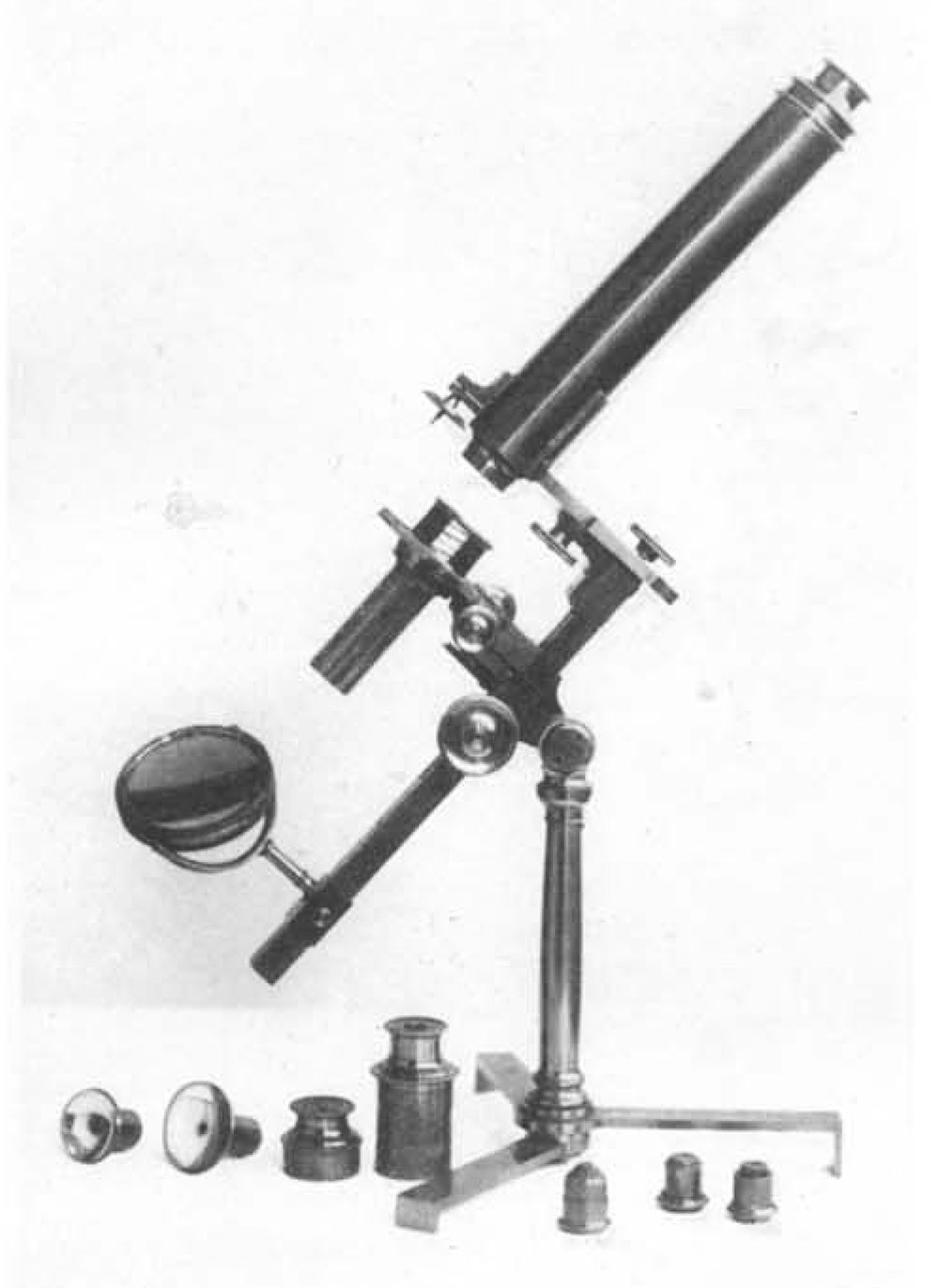
Figure 1.
Achromatic microscope signed "W. Elliott, 268 High Holborn". Manufacture attributed to James Smith and dated ca. 1839 by Clay and Court (1930). Before he began selling microscopes under his own name, Smith "worked for the trade" (i.e. worked on commission for retailers such as Elliott and Andrew Pritchard).
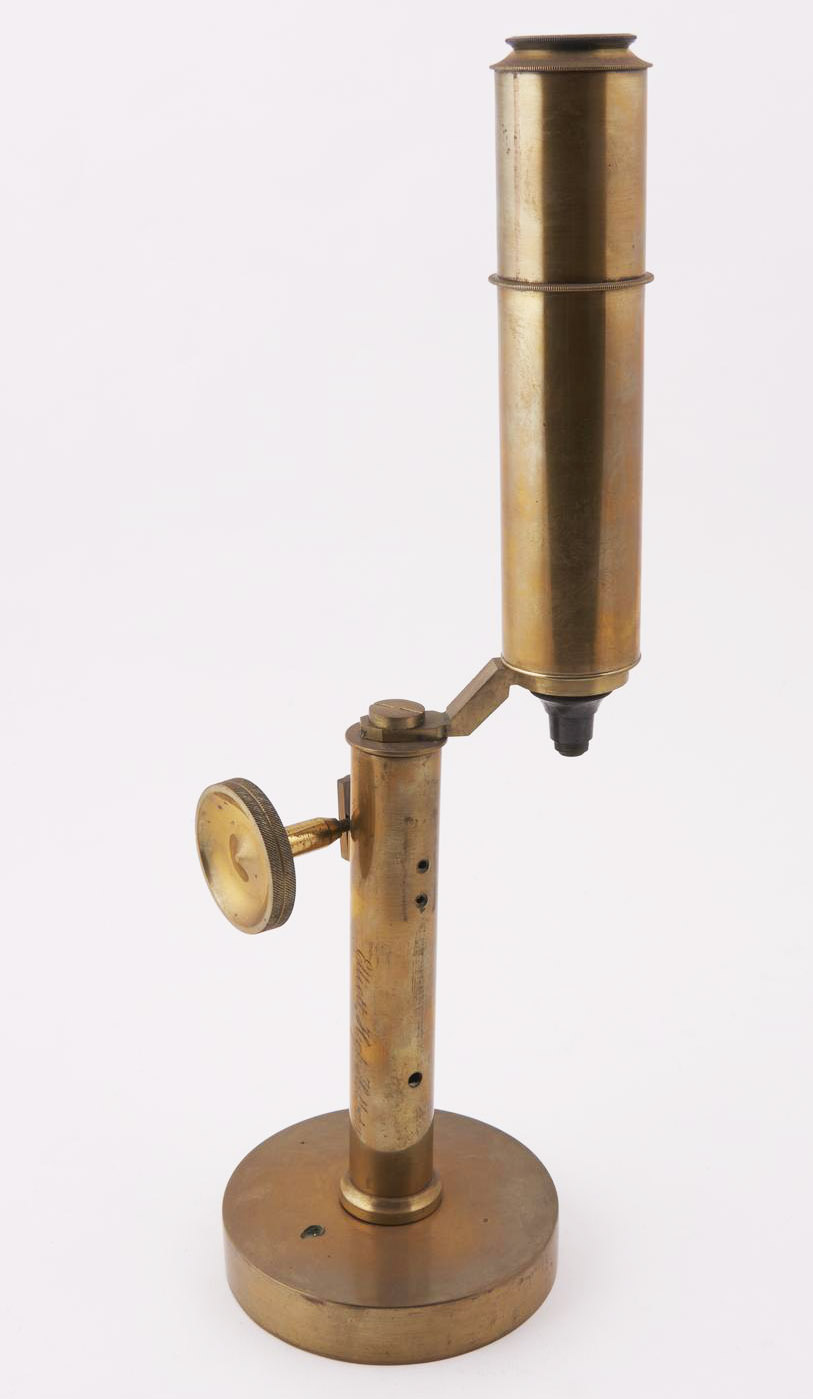
Figure 2.
Microscope signed by William Elliott, High Holborn. Elliott was primarily a maker of engineering and drafting instruments, and not known for making microscopes, so this may have been acquired for resale from a wholesale manufacturer. The stage and mirror are missing. Adapted for nonprofit, educational purposes from https://collection.sciencemuseumgroup.org.uk/objects/co119078/student-microscope-by-william-elliott .
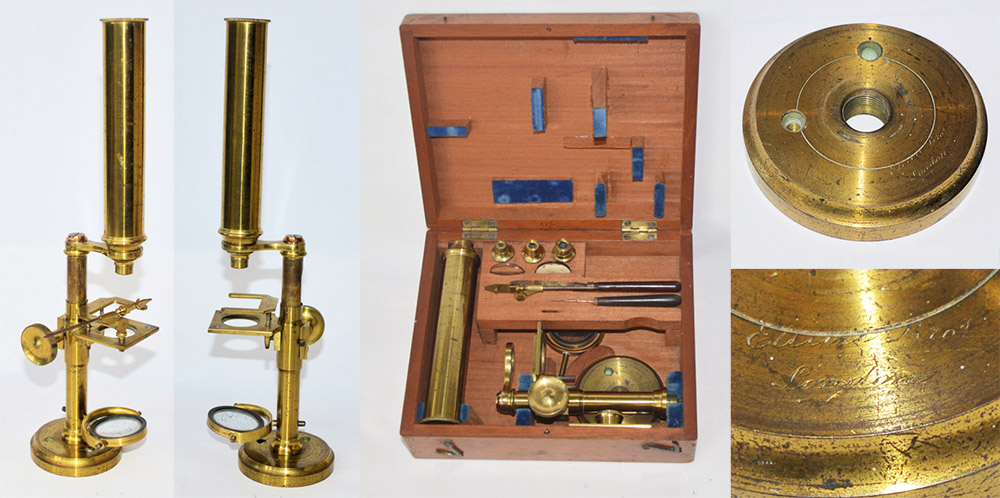
Figure 3.
Microscope engraved "Elliot Brothers, London". The same model had been manufactured by Watkins and Hill, and production was undoubtedly continued by Elliott Brothers after they acquired Watkins and Hill in 1856 (see Figure 6). This example probably dates from between 1856 and 1858, when Elliott Brothers had two business locations in London. To judge from the number of surviving instruments, Elliott Brothers appear to have manufactured a good number of this model. Adapted for nonprofit, educational purposes from an internet sale site.
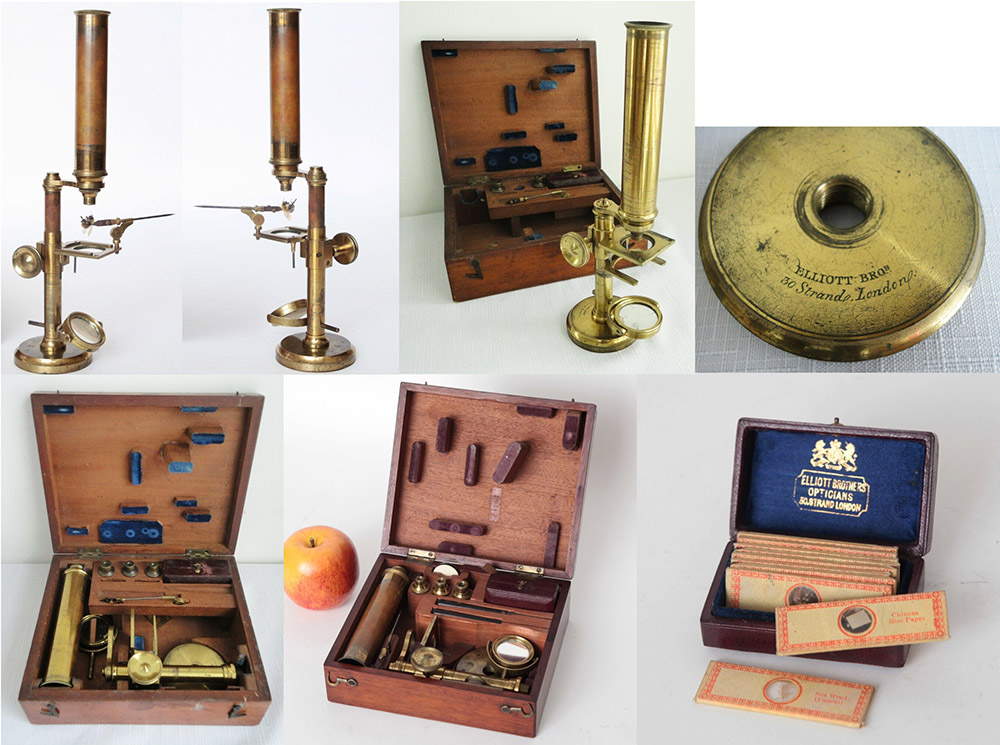
Figure 4.
Two microscopes engraved "Elliot Brothers, 30 Strand", dating them to after the move to that location in 1858. The cabinets hold similarly-labeled cases of small, "continental-sized" slides. Adapted for nonprofit, educational purposes from internet sale sites.
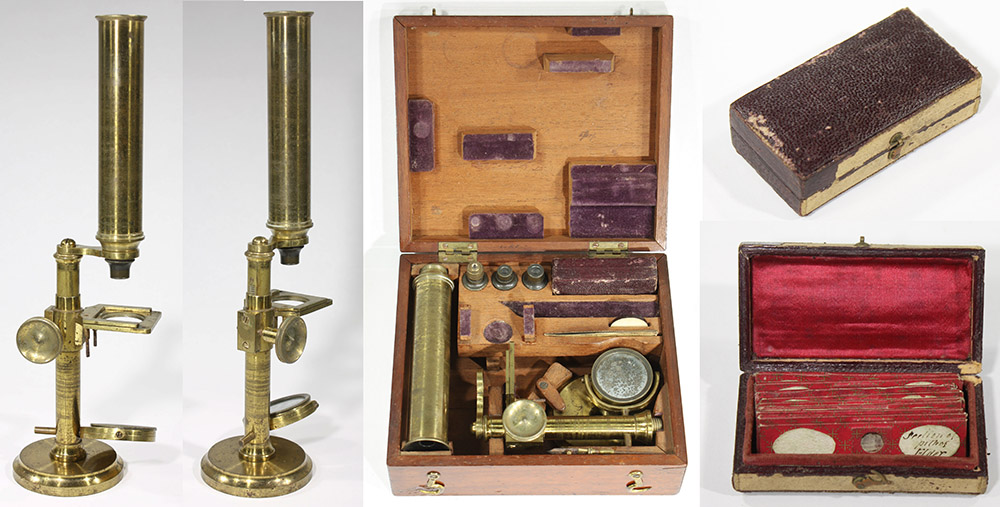
Figure 5.
An unsigned microscope of the same model, and with the same style of cabinet and accessories, as shown in Figures 3 and 4. The features indicate production by Elliott Brothers, from after 1856.
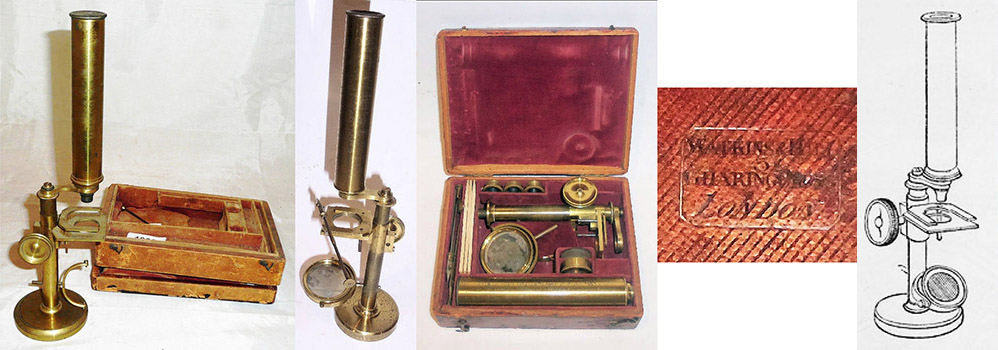
Figure 6.
Two microscopes that are identical to those shown in Figures 3-5, but marked "Watkins and Hill", and an engraving of this model from a ca. 1850 Watkins & Hill catalogue. Note that the cases are different in design from those sold by Elliott Brothers.
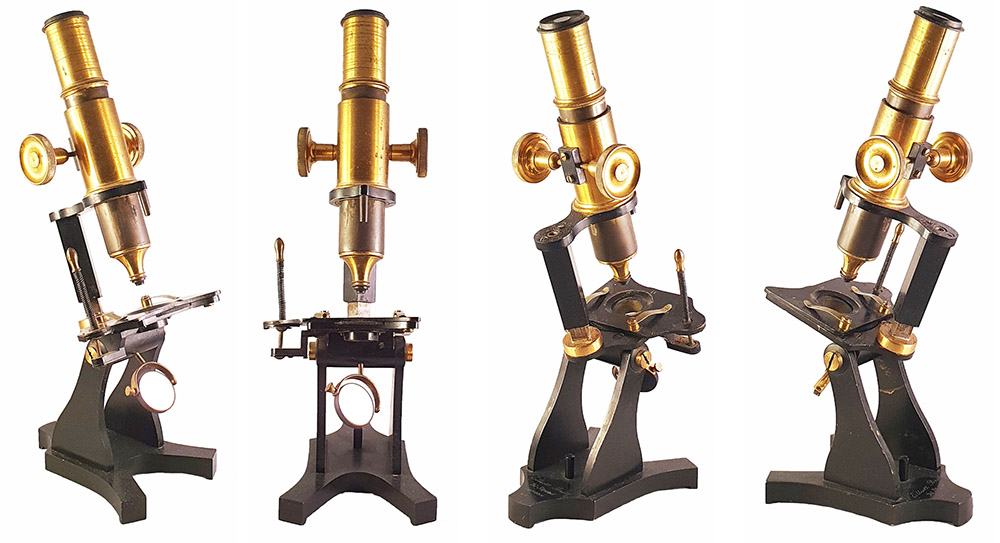
Figure 7.
Microscope signed "Elliott Bros, 30 Strand, London". A number of microscopes are known that bear other retailers' names or are unsigned, and were probably produced ca. 1860s by Mirand, Paris. Adapted by permission from https://www.antiquemicroscopes.co.uk/m238.html .
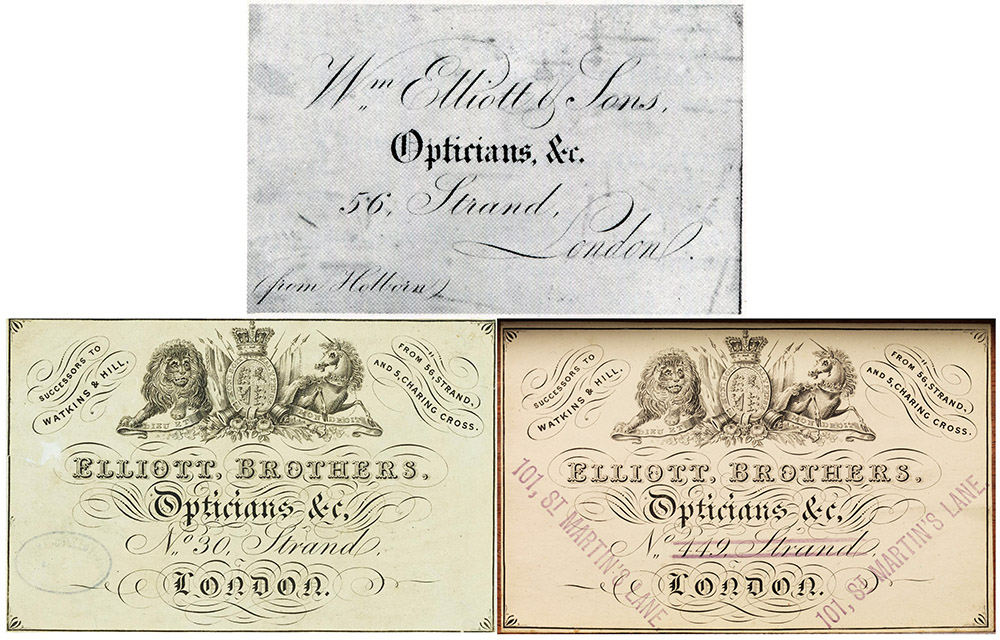
Figure 8.
Trade cards from Elliot & Sons and Elliott Brothers. Top: Wm. Elliott & Son, ca. 1849-1853. Lower left: Elliott Brothers, 30 Strand, ca. 1858-1866. Lower right, Elliott Brothers, 419 Strand crossed out, 101, 102 St. Martin's Lane overstamped, ca. 1880. Adapted for nonprofit, educational purposes from Clifton (1995), https://collection.sciencemuseumgroup.org.uk/objects/co8002194/trade-card-elliott-brothers, and https://www.rmg.co.uk/collections/objects/rmgc-object-43718
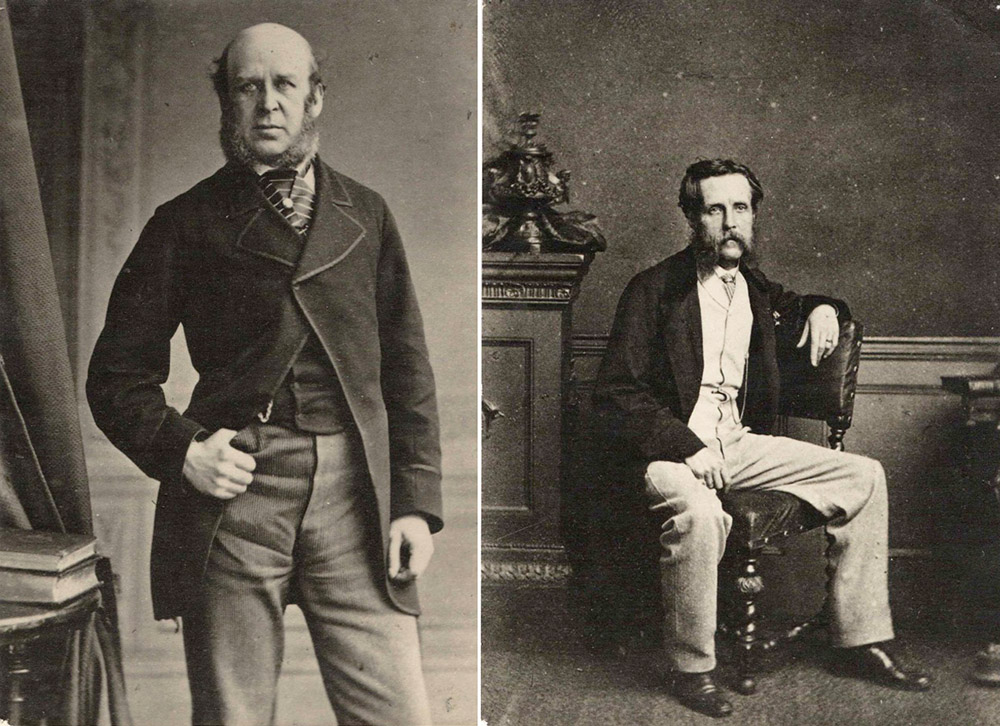
Figure 9.
Frederick and Charles Elliott (left and right, respectively). Adapted from https://threepointsofthecompass.com/2022/07/09/map-measure-of-the-month-elliott-brothers-opisometer .
Later census records indicate that William Elliott was born ca. 1781 in London. Apprenticeship records state that his father's name was also William, and was a "yeoman of London", i.e. he was not a guild member. Those data suggest that our William Elliott may have been the child who was baptized on May 6, 1781 at St. Andrew, Holborn, son of William and Hannah Elliott, of Baldwin Gardens.
William was apprenticed in 1795 to William Backwell, a maker of mathematical and drafting instruments. According to Clifton, Elliott was re-bound to Thomas Collingridge, a coach manufacturer, for the purpose of eventually gaining membership in a guild (the Coach and Coach Harness Makers Company), although he remained with Backwell for his training. In those times, membership in a guild was important for business purposes, but the business did not need to match the historical name of the guild.
Later histories of the Elliott business stated that William Elliott began his own business in 1800, at "Sash Street, Gray's Inn". These are incorrect, and apparently confused the address of Backwell's business, which was at Tash Street, Gray's Inn. Elliott probably did not establish his own shop until 1804.
Elliott was made a Freeman of the the Coach and Coach Harness Makers Company in June, 1804. He evidently already owned his own mathematical instrument business, having taken an apprentice in April, 1804. The location of Elliott's initial shop is not known. He was reported to be working from 20 Wilderness Row, Goswell Street ca. 1817. Elliott is not known to have appeared in London business directories until 1820, suggesting that he may have "worked for the trade", i.e. produced items for other retailers but not sold under his own name.
William Elliott married Emma Paget on May 14, 1818. He was listed as "widower" on their marriage record. Nothing is known about William's previous wife, and there are no records of children. William and Emma had four children: Frederick Henry, George Augustus, Charles Alfred, and Eliza. Frederick and Charles later formed a business partnership with William.
The earliest record that I found of William Elliott in a business directory is his 1820 entry in the Post Office Directory of London, "Elliott W. Mathematical-instrument-maker, 21, Gt. Newport-str". Son Frederick was born the previous year, with his baptism record also giving the address of 21 Great Newport Street.
Footnotes of publications about scientific and engineering instruments give insights on William Elliott's early products (Figure 10). An 1824 note in The Chemist stated that Elliott sold (and, perhaps produced) blow-pipes for chemical analyses. An 1828 paper by J.W. Woolgar on his "improved six-inch plotting and protracting scale" stated that Elliott produced those rulers in ivory and boxwood. An 1833 paper on perspective drawing by Joseph Jopling stated that Elliott had "what models, molds, and instruments are desirable" for the subject. Jopling further wrote, "Mr. Elliott has, as a manufacturer of mathematical instruments, given such general satisfaction to professional gentlemen, that the author feels himself fully warranted in recommending him on the present occasion". In 1847, William Elliot was recommended as the prime source for tools useful for setting appropriate curves for railways. A ca. 1834-49 theodolite that was made by Elliott is shown in Figure 11.
Elliott moved to 227 High Holborn ca. 1828. He was listed at 21 Great Newport in an 1825 London directory. Between 1833 and 1834 the address changed from 227 to 268 High Holborn; whether this was a physical move or a change in addressing is not clear.
William Elliott's business was financially successful. The 1841 census recorded that the family employed a domestic servant, and could afford to send their children to exclusive colleges.
Eldest son Frederick enrolled at Christ's College, Cambridge University, in 1841. He graduated with a B.A. in 1845 and M.A. in 1848. Frederick then worked as a surveying engineer during that period of rapid expansion of railway construction. An obituary noted that he "acquired a practical knowledge of instruments, which in after-life he turned to excellent account". Frederick married Susan Pearse on October 12, 1848. The pair did not have any children. Their marriage record gave Frederick's occupation as "engineer" and address of 30 King Street.
Charles' 1846 marriage record gave his occupation as "optician" and address of High Holborn, suggesting that he probably worked for his father before partnering with William and Frederick. Charles married Maria Sarvis on June 10, 1847. They had one child, Gertrude.
William formed a partnership with Frederick and Charles at some point before August 21, 1849. An advertisement published on that day stated that "W. Elliott & Sons, Opticians, &c." had moved from 268 High Holborn to 56 Strand (Figure 12).
The 1851 national census recorded William, Emma, unmarried daughter Eliza, an eight year-old granddaughter, and two house servants living at the 56 Strand shop, while Frederick and Susan lived with her parents in Islington, and Charles, Maria, and Gertrude lived in Stoke Newington.
Elliott and Sons exhibited at the 1851 London Great Exhibition of the Works of Industry of All Nations, showing "drawing instruments, dumpy-level, theodolites, transit instrument, new instrument for measuring distance, telescopes, opera glasses, standard English yard, slide rule, azimuth and altitude instrument, &c." (Figure 13). Failure to mention microscopes implies that such instruments were either not being manufactured by Elliott and Sons or were a minor product. In the stall adjacent to Elliott and Sons, J.A. Lloyd exhibited a "typhodeictor, or storm pointer, an instrument for obtaining, by inspection, the bearing and relative position of a revolving storm or hurricane" that was manufactured for Lloyd by Elliott and Sons. Next to Lloyd was a exhibit of drawing instruments by J. Dobson, who then occupied Elliott's old shop at 268 High Holborn.
William Elliott died in May, 1853. Frederick and Charles then continued the business as "Elliott Brothers".
In 1856, Elliott Brothers acquired the Watkins and Hill business, which was a large manufacturer and retailer of optician, mathematical, and scientific apparatus. As Gee (2016) wrote, "the purchase of this long-established business, with its customer base, a handful of loyal, experienced employees, and a ready-made network of suppliers, and, most importantly, the goodwill of the Watkins family name, immediately placed them alongside the broad-ranging companies", and allowed for retirement of the owner, 60-year old Mary Ann Watkins. With this acquisition, Elliot Brothers now operated two shops, at their old 56 Strand and the Watkins and Hill shop at 5 Charing Cross (Figure 17).
They combined both shops into "more extensive premises" at 30 Strand in mid-1858 (Figure 18). This was partly driven the building of Charing Cross Station. The Electrical Review (1901) recalled that"before the removal was effected the railway company commenced to undermine the foundations, with the result that the whole of the workshops at the rear of the building collapsed!" Manufacturing was moved to a separate location at 112 St. Martin's Lane.
They moved again, to 449 Strand, in the early 1860s. A second manufacturing plant was established at 102 St. Martin's Lane in 1868.
The brother's partnership was dissolved in 1870 (Figure 19). The business continued under the name of Elliott Brothers, but with Frederik as sole owner. Charles evidently pursued other business interests; for example, as early as 1867 he sat on the Board of Directors of South Swaledale Lead Mining Company, Ltd. Charles died in early October, 1877.
Frederick Elliott "died suddenly of apoplexy" on January 18, 1873. Legal records indicate that he died at his shop at 449 Strand, rather than at home in Kent. Susan inherited the business.
Through the years, the Elliott Brothers' inventory turned to electronics and metering devices. For example, at the 1875 Conversazione of the Society Of Telegraph Engineers, Elliott Brothers exhibited, "Condenser. 1 Microfarad capacity as designed by Major Malcolm, R.E, subdivided into 12 parts, to measure from 0.001 to 0.5; Small Condenser, as designed by Major Malcolm, R.E., 0.1 microfarad capacity, subdivided into 4 parts, from 0.01 to 0.05; Electrometer. A modification of Sir William Thomson's Quadrant Electrometer; Replenisher. For use with quadrant electrometer; Platinum-Silver Resistance Coils, as designed by Major Mallock for use in India; Hearson's Patent Strophometer, for showing the number of revolutions per minute of machinery on a dial, and also registering the same on a strip of paper. Used also for applying to the paying-out gear of a cable-ship; Small-sized Strophometer." At the 1876 Society Of Telegraph Engineers' Conversazione, there was "a fine collection of instruments for the measurement of electrical resistances constructed by Messrs. Elliott Brothers, exhibiting all the scientific accuracy and beauty of workmanship for which that firm has so great a name."
ca. 1876, Susan Elliott formed a partnership with Willoughby Smith (1828-1891), a well-established electrical engineer. The day-to-day business was managed by Charles Becker, who is mentioned as Elliott Brothers' point-man in many journal articles of the time. Smith's son, William Oliver Smith, joined the firm, too. New manufacturing buildings were erected at at 101 and 102 St. Martin's Lane.
Susan Elliott died on March 26, 1880, leaving an estate valued at around £20,000. She did not have any children, so the estate was probably divided among various relatives.
Willoughby and William O. Smith continued to operate Elliott Brothers. After Willoughby Smith died in 1891, W.O. Smith "entered into arrangements with Mr. G.K.B. Elphinstone, the proprietor of the business of Theiler & Son, of Canonbury, telegraph instrument makers, to amalgamate the businesses under the style of Elliott Bros.". The firm moved to Conington Road, Lewisham in 1900. In 1905, it was reported to employ 420 workers. The company was owned by various entities through the twentieth century, with several merger, splits, and name changes through the years. The Elliott name ended with the formation of English Electric in 1967.
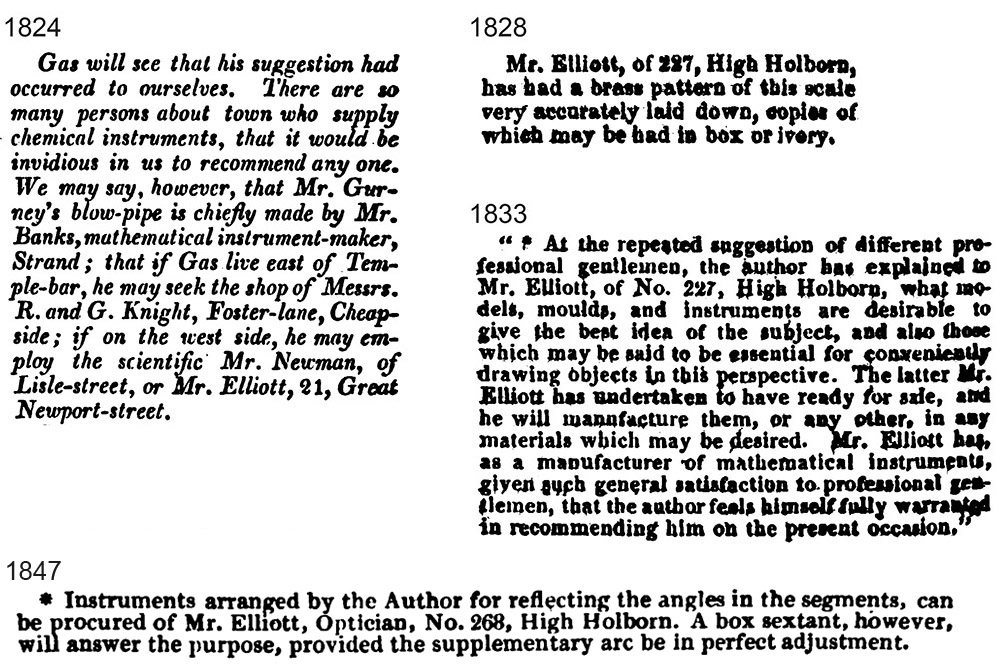
Figure 10.
Figure 10. Published notes on products manufactured by William Elliott. 1824, he sold (and, perhaps produced) blow-pipes for chemical analyses; from "The Chemist". 1828, he produced Woolgar's "improved six-inch plotting and protracting scale" in ivory and boxwood; from "Mechanic's Magazine". 1833, he produced "models, molds, and instruments" for perspective drawing; from "Mechanic's Magazine". 1847, he produced tools for calculating angles of curves; from "A New Method of Setting out Railway Curves".
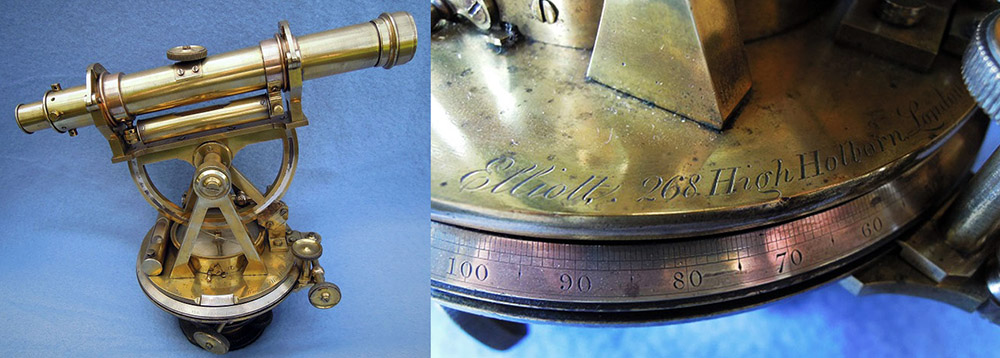
Figure 11.
A theodolite that was produced by William Elliott. It is engraved with his address of 268 High Holborn, dating it to between ca. 1834 and 1849. Adapted for nonprofit, educational purposes from Grace's Guide.

Figure 12.
An August 21, 1849 advertisement that announced the relocation of W. Elliott and Sons to 56 Strand. This indicates that the father-sons partnership was formed in 1849, at the latest, and not in 1850 as is commonly reported. From "Allen's Indian Mail".
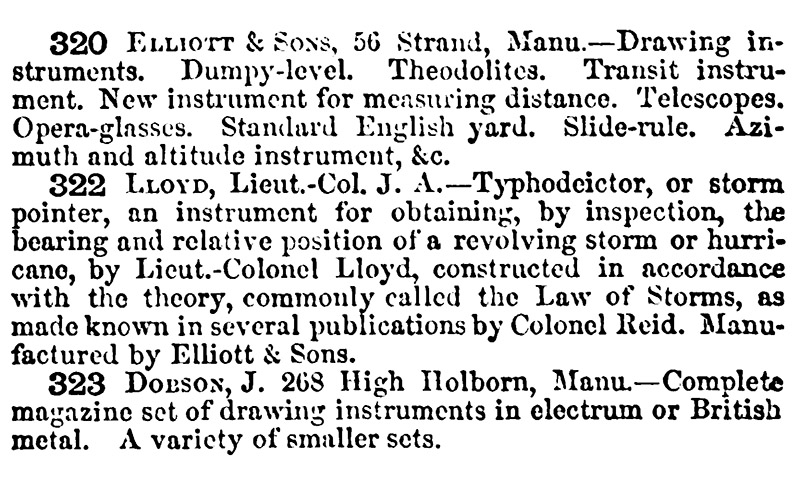
Figure 13.
Elliott and Sons exhibited a variety of mathematical and engineering implements at the 1851 London International Exhibition. They also manufactured the instrument that was exhibited by J.A. Lloyd in the next stall. J. Dobson, who displayed in the stall adjacent to Lloyd, occupied Elliott's former premises of 268 High Holborn.

Figure 14.
An 1862 advertisement for "A Treatise on the Slide Rule", published by Elliott and Sons. They also manufactured the described instrument. The Reverend William Elliott was on the faculty of Queen's College, Cambridge University, and is not known to be related to the instrument making Elliott family. From "The Mechanics' Magazine".

Figure 15.
An 1853 advertisement for Elliott and Sons' batteries, intended for "medical" uses, from "The Lancet". "Blackwood's Lady's Magazine" wrote "we feel certain that for those cases where electricity has been found beneficial, this miniature galvanic machine will prove of great value, as its simplicity is such that the most ordinary intelligence on the part of the patient cannot fail to insure a mild and continuous current in one direction, and by employing the whole of the elements a succession of minute sparks, or a current of sufficient intensity is produced as will excoriate the skin, or by using a less number of the bars forming the electrical combination, a current of proportionately less power is obtained, admirably adapted for the use of the nervous invalid, and its moderate price brings it within the reach of every one requiring such aid."
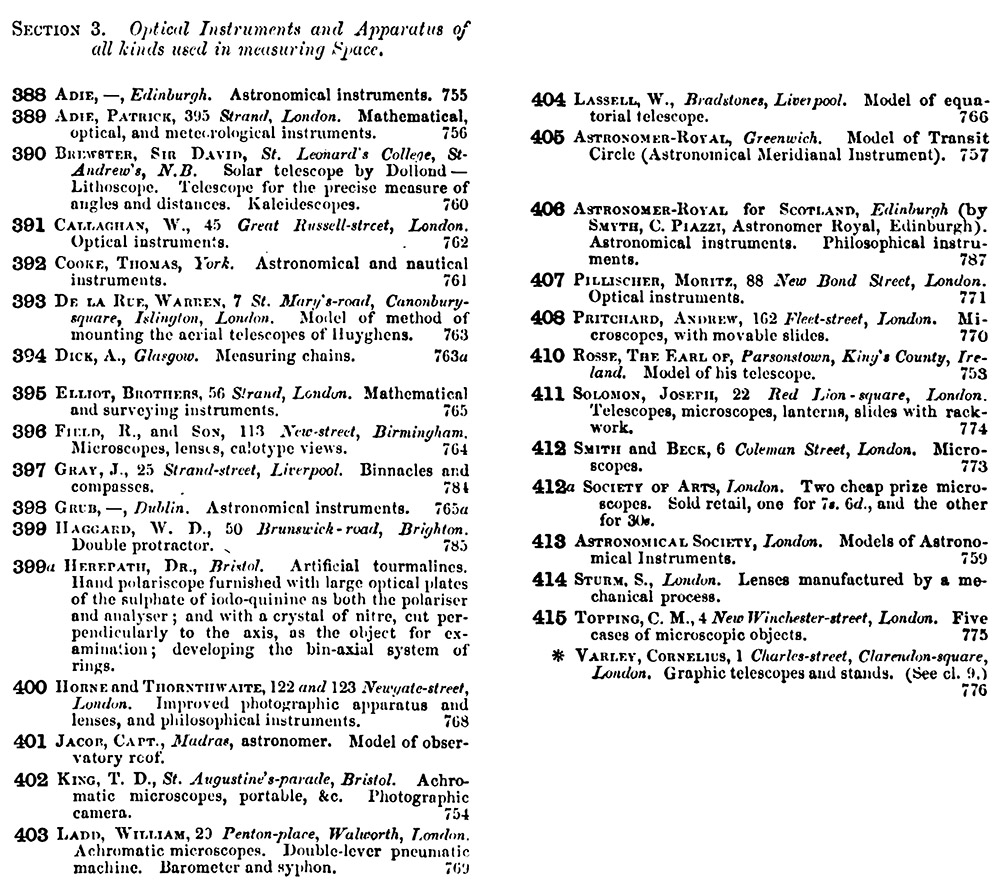
Figure 16.
British exhibitors of optical instruments and apparatus at the 1856 Paris International Exposition. Elliott Brothers showed "mathematical and surveying instruments", which were their major products. They had not yet formally acquired Watkins and Hill and their Charing Cross shop.
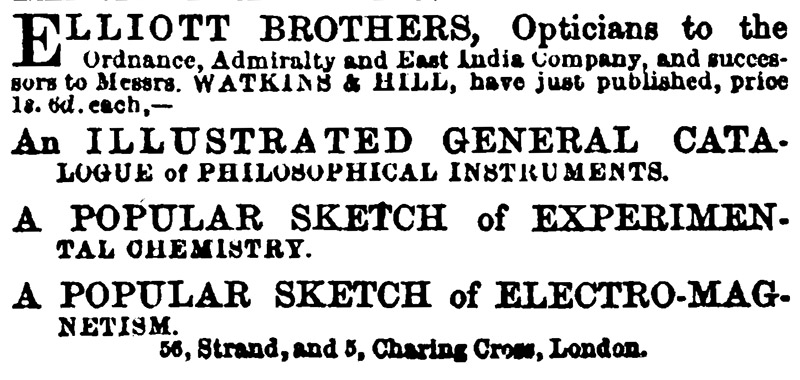
Figure 17.
An 1857 advertisement, from "The Athenaeum".

Figure 18.
An 1858 advertisement that documents Elliot Brothers' move from 56 Strand & 5 Charing Cross to 30 Strand. From "The Athenaeum".
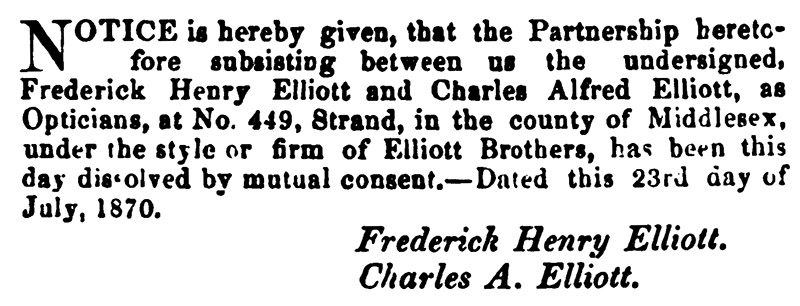
Figure 19.
Notice of dissolution of the partnership between Frederick and Charles Elliott, dated July 23, 1870. The business continued under the name "Elliott Brothers", but with Frederick as sole owner. From "The London Gazette".
Acknowledgements
Thank you to Joe Zeligs for sharing images from his amazing database of microscope pictures and information, and to Joao Inacio Silva for sharing images of his Elliott Brothers' microscope.
Resources
Allen's Indian Mail (1849) Advertisements from W. Elliott and Sons, August 21 issue, page 510, and several later issues
The Athenaeum (1857) Advertisement from Elliott Brothers, page 959
The Athenaeum (1858) Advertisement from Elliott Brothers, page 219
Baptism record of William Elliott (1781) Parish records of St. Andrew, Holborn, accessed through ancestry.com
Baptism record of Charles Alfred Elliott (1822) Parish records of St. Martin in the Fields, accessed through ancestry.com
Baptism record of Frederick Henry Elliott (1819) Parish records of St. Martin in the Fields, accessed through ancestry.com
Blackwood's Lady's Magazine (1853) Stringfellow's Electro-Galvanic Pocket Battery, W. Elliott and Sons 56 Strand, pages 38-39
Burial record of William Elliott (1853) Parish records of St. Giles in the Fields, accessed through ancestry.com
Burial record of Charles Alfred Elliott (1877) Parish records of Whitton, Middlesex, accessed through ancestry.com
The Chemist (1824) Note on Gurney's blow-pipe, page 128
Clay Reginald S., and Thomas H. Court (1930) Early achromatic microscopes by James Smith, Journal of the Royal Microscopical Society, pages 292-301
Clifton, Gloria (1995) Directory of British Scientific Instrument Makers, 1550-1851, Zwemmer, London, pages 13 and 95
The Electrical Review (1900) Messrs. Elliott Brothers works at Lewisham, Vol. 48, pages 1023-1025
The Electrician (1905) The works of Messrs. Elliott Bros, pages 1041-1044
Elliott, William (1834) Letter to the editor (with address of 268 High Holborn), Iron, page 217
Engineering (1876) Conversazione of the Society of Telegraph Engineers, Vol. 22, pages 527-528
Freedom of the City of London record of William Elliott (1804) June, Coach & Coach Harness Makers, accessed through ancestry.com
Gee, Brian (2016) Francis Watkins and the Dollond Telescope Patent Controversy, ed. by A. McConnell and A.D. Morrison-Low, Routledge, Abingdon
Grace's Guide to British Industrial History (accessed October, 2025) Elliott Brothers, https://www.gracesguide.co.uk/Elliott_Brothers
Heather, John F. (1859) A Treatise on Mathematical Instruments, fifth edition, J. Weale, London, includes catalogue of mathematical and other instruments sold by Elliott Brothers
Heather, John F. (1866) A Treatise on Mathematical Instruments, sixth edition, Elliott Brothers, London, includes catalogue of mathematical and other instruments sold by Elliott Brothers
History of the Atlantic Cable & Undersea Communications (accessed October, 2025) Report of the 1875 Conversazione of the Society Of Telegraph Engineers, https://atlantic-cable.com/Article/1875Conversazione/index.htm
The Joint Stock Companies' Directory (1867) South Swaledale Lead Mining Company, Ltd., page 567
The Lancet (1853) Advertisements for Stringfellow's Patent Electro-Galvanic Portable Battery, multiple issues
The London Gazette (1870) Dissolution of Elliott Brothers, page 3537
Marriage record of William Elliott and Emma Paget (1818) Parish records of Sts. Anne and Agnes Aldgate, accessed through ancestry.com
Marriage record of Charles Alfred Elliott and Maria Sarvis (1846) Parish records of St. George Hanover Square, accessed through ancestry.com
Marriage record of Frederick Henry Elliott and Susan Pearse (1847) Parish records of St. George Bloomsbury, accessed through ancestry.com
May, R.C. (1847) A New Method of Setting out Railway Curves, by Reflecting the Angle in a Segment, second edition, J. Weale, London, page 2
Mechanic's Magazine (1833) Review of "The Practice of Isometrical Perspective" by Joseph Jopling, pages 289-295
Mechanic's Magazine (1852) Advertisements for Rev. W. Elliott's "A Treatise on the Slide Rule" February 7 and 21, Advertiser page 1
Monthly Notices of the Royal Astronomical Society (1873) Obituary of Frederick Elliott, Vol. 34, page 139
Official Catalogue of the Great Exhibition of the Works of Industry of All Nations (1851) fourth edition, Royal Commissioners, London, page 64
Paris Universal Exhibition, 1855: Catalogue of the Works Exhibited in the British Section (1855) Imperial Commission, London, page 23
Pigot's Directory of London (1822) "Elliott Wm. optician, 21, Gt. New-" page 189
Pigot's Directory of London (1825) "Elliott Wm. optician, 21, Gt. Newport-st" page 187
Post Office Directory of London (1811) "Backwell Wm. mathematical instrument maker, Tash-st. Grays Inn Lane"
Post Office Directory of London (1820) "Elliott W. Mathematical-instrument-maker, 21, Gt. Newport-str.", page 115
Post Office Directory of London (1843) "Elliott Wm. mathematical, optical, philosophical & drawing instrument maker, 268 High Holborn", page 172
Post Office Directory of London (1847) "Elliott Wm. mathematical, optical, philosophical & drawing instrument maker, 268 High Holborn", page 713
Post Office Directory of London (1875) "Elliott Brothers, mathematical, optical & philosophical instrument manufacturers, 449 Strand WC & 101 & 112 St. Martin's lane WC", page 881
Post Office Directory of London (1880) "Elliott Bros. 449 Strand WC & 101 St. Martin's la WC", page 54
Probate of the will of Frederick Elliott (1873) "Elliott Frederick Henry. 12 February. Administration of the effects of Frederick Henry Elliott late of Sangley Lodge Catford Bridge in the County of Kent who died 18 January 1873 at 449 Strand in the County of Middlesex was granted at the Principal Registry to Susan Elliott of Sangley Lodge Widow the Relict. Effects under £10,000. (handwritten: Resworn February 1880 under £35,000 Administration of Goods Unadministered passed at the Principal Registry August 1880)", accessed through ancestry.com
Probate of the will of Susan Elliott (1880) "Elliott Susan. 30 April. The Will with three Codicils of Susan Elliott late of Sangley Lodge Catford Bridge in the County of Kent Widow who died 26 March 1880 at Sangley Lodge was proved at the Principal Registry by William Reade Brander of 22 College-hill in the City of London Land Agent George Davey Stibbard of 21 Leadenhall-street London Solicitor and Richard Woodley Burrows of Twickenham in the County of Middlesex Brewer the Executors. Personal Estate under £20,000", accessed through ancestry.com
Record of William Elliott taking William Harman as apprentice (1804) accessed through ancestry.com
Robson's Directory of London (1830) "Elliott Wm. Optician & manfr. of drawing instruments, 227 High Holborn"
Robson's Directory of London (1839) "Elliott Wm. Mathemticl instmt mkr, 268 High Holborn", page 476
Robson's Directory of London (1842) "Elliott Wm. Mathemactl inst mkr, 268 High Holborn", page 534
Taylor, Eva G.R. (1966) The Mathematical Practitioners of Hanoverian England, 1714-1840, Cambridge University Press, Cambridge, page 390
Watkins, Francis (1856) A Popular Sketch of Electro-Magnetism, or Electro-Dynamics, Elliott Brothers London
Watkins and Hill (ca. 1850) Descriptive Catalogue of Optical Instruments and Apparatus, accessed from wellcomecollection.org/works/zyhrfzk5
Woolgar, J.W. (1828) Description of an improved six-inch plotting and protracting scale, designed by J.W. Woollgar, Esq., Mechanic's Magazine, pages 56-58


















